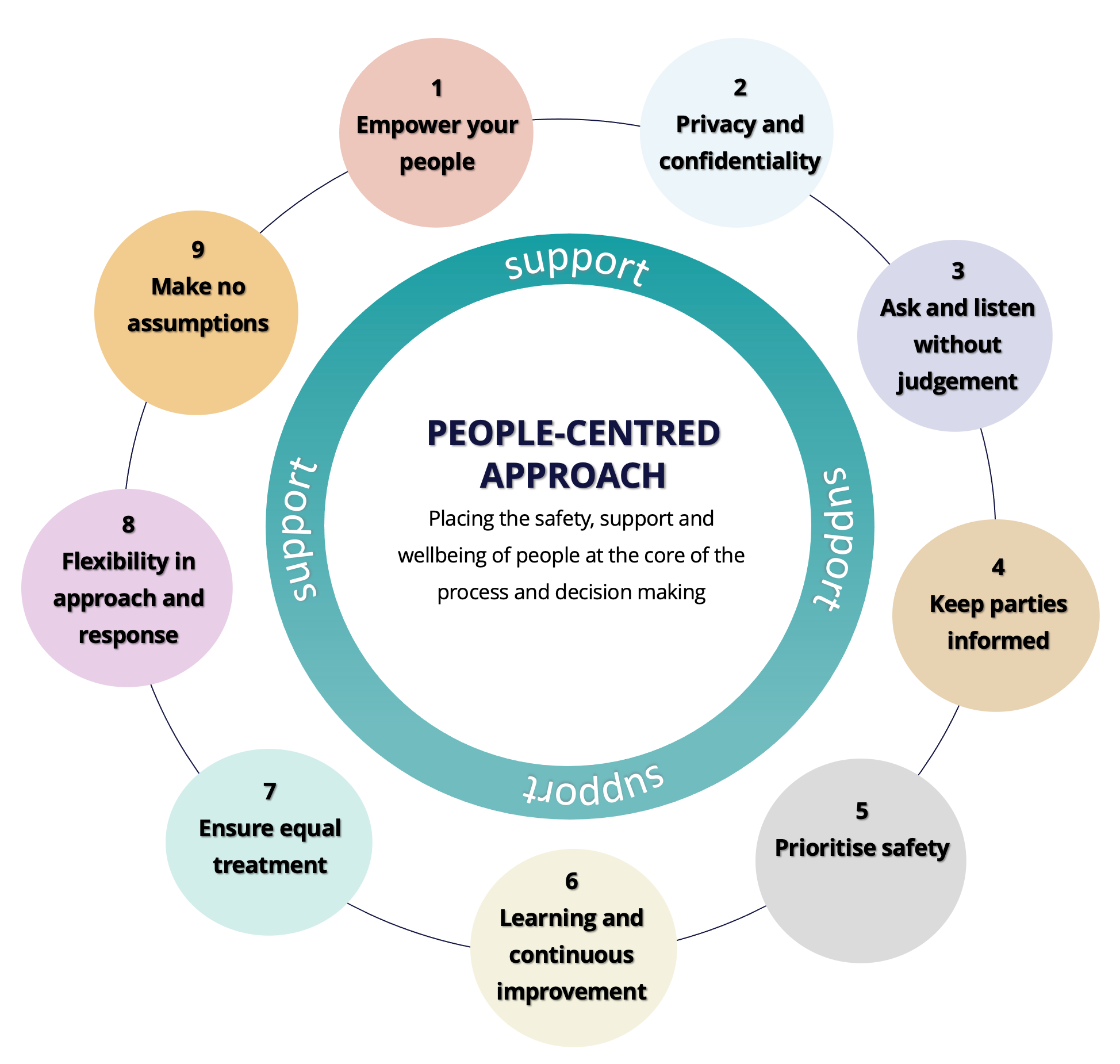Person centred approaches to workplace sexual harassment
What does taking a person-centred approach when responding to sexual harassment mean and how to do it.

A person-centred approach to workplace sexual harassment means placing people - the targets of sexual harassment - at the centre of any response to sexual harassment. It is about listening to, empowering and supporting people who are impacted by sexual harassment.
Champions of Change Coalition in their guide Sexual Harassment: Respect and Support Impacted People, describes person-centred approaches to sexual harassment as:
Person-led means the individual impacted chooses how they wish to report it and is involved in the decision about how to handle the issue. It respects the wishes and best interests of the person impacted, but does not mean they solely decide the organisation's response or consequences for the offender because the organisation still owes a duty of care to others. A person-centred approach also recognises that people will share their experience when they feel comfortable and that it may take people time to process what has happened and feel ready to talk. An overly restrictive time limitation between the incident and the report can be a barrier to people speaking up.
A person-centred approach differs from a service or system based approach. In the past organisations have tended to rely on existing systems and practices when responding to sexual harassment. This systems dependent approach fails to recognise and acknowledging the unique experiences and impacts sexual harassment can have on an individual. Taking purely a systems approach to a unique situation doesn’t work. It’s important, therefore, to recognise the difference between the two approaches.
| Person-centred | Service/system centred |
|---|---|
| Talking with the person | Talking about the person |
| Listening to the person | Directing and instructing the person |
| Planning with the person | Planning for the person |
| Focus on individual needs, wishes and circumstances | Focus on a persons environment, weaknesses and impact on the organisation |
| Finding solutions that work for the individual | Applying broad and blanket solutions tailored for the organisation |
| Understanding a person's context | Applying broad contextual/organisational understandings of the situation |
| Respecting the person's position in the organisation as equal | Consideration of positional hierarchy as a factor in determining a solution |
A response system that prioritises people’s wellbeing is not only more likely to increase trust and engagement, it also supports the recovery process for all parties involved. This in turn increases the likelihood of victims coming forward to report and the chances of satisfactory resolution for everyone.
The core elements of a people-centred approach and the interdependencies of support and reporting systems are illustrated below. These nine elements have been adapted from the UN Women’s victim-centred approach to addressing sexual harassment. Further information can be found in the UN Women’s discussion paper, What Will it Take? Promoting Cultural Change to End Sexual Harassment.
Much of the literature, including Respect@Work, uses the term "victim-centred". Here we focus on being “people-centred”. This inherently includes being victim-centred, but it also recognises that that other people may also suffer harm if sexual harassment occurs, such as bystanders and other impacted persons.

1. Empower your people
Empower victims to make decisions about whether they make a report and how they do so. The victim’s preferences are considered in how a report of sexual harassment is most appropriately addressed.
2. Privacy and confidentiality
Individuals are aware of the ripples of knowledge when making a report of sexual harassment.
3. Ask and listen, without judgment
Give individuals space and time to tell their story and provide supportive responses, free from judgment or bias.
4. Keep parties informed
Individuals should be aware of who the information will be shared with and be kept updated on the process.
5. Prioritise safety
Ask individuals about their safety concerns and put in place measures to mitigate safety risks and to support impacted individuals.
6. Learning and continuous improvement
Commit to continuous improvement in managing cases of sexual harassment and be open to feedback and lessons on how things can be done better.
7. Ensure equal treatment
Apply the people-centred approach to all parties, ensuring equal access to support through the process and communicate in a respectful and neutral way.
8. Flexibility in approach and response
Have a robust response framework that anticipates an individual’s distress from their experience and provides flexibility and choice in how a report of sexual harassment can be resolved and treat each case on its own facts.
9. Make no assumptions
Treat each case on its own set of facts and have an openness about what may have occurred, including that the report may be accurate.
For a people-centred approach to be effective and actively used in your organisation, each of the nine elements need to be embedded into:
- how you implement and carry out your processes
- how you support your people before, during and after an incident is reported
- how you respond, i.e. your complaint handling and consequence management processes
How to implement and carry out your processes
To embed a people-centred approach, your organisation will first need to commit to how these principles will be applied. A practical way your organisation can do this is through a charter, detailing how you will apply the principles of people-centred practice when responding to reports of sexual harassment.
To ensure that your charter’s commitments are active in your response processes, you will need to integrate them into all supporting tools and processes (for example, your resolution procedure, sexual harassment policy, health and safety policy, investigation framework, consequence management processes). This will require you to consider each people-centred principle in line with your processes.

